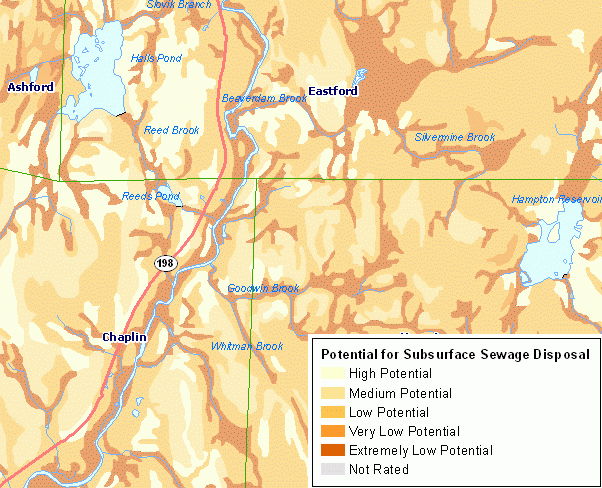
The Soil Potential Ratings for Subsurface Disposal Systems data indicates the relative suitability of soils for installing a single family residence subsurface disposal system (SSDS), as well as ways those limitations may be overcome. For additional documentation including a description of the map legend for Potential Subsurface Sewage Disposal System, refer to the CT ECO Complete Resource Guide for Potential Subsurface Sewage Disposal System.
All soil information included in the CT ECO maps and map viewers is from the Natural Resources Conservation Service (NRCS) Web Soil Survey (WSS), which is based on information originally published on the set of Soil Survey quarter quadrangle maps that cover Connecticut.
Soil potential ratings are classes that indicate the relative quality of a soil for a particular use compared to other soils in a given area. These soil potentials were developed for planning purposes and are not intended as recommendations for soil use. The special requirements identified to overcome soil limitations are a guide to planning and are not to be applied at a specific location without on-site investigation for design and installation. SSDS are systems consisting of a house sewer, a septic tank followed by a leaching system, any necessary pumps and siphons, and groundwater control system on which the operation of the leaching system is dependent. This interpretation focuses mainly on the septic tank leaching field and groundwater control system. A typical SSDS is assumed to be for a single family, 4-bedroom home on a 1-acre lot with a private well, or a ½-acre lot with public water supply. The system has a 1250 gallon septic tank and a 660 to 1000 square foot leaching field. This interpretation identifies the soil characteristics that are present in order for a typical system to be constructed.
This data set is not designed for use as a primary regulatory tool in permitting or siting decisions, but may be used as a reference source. This is public information and may be interpreted by organizations, agencies, units of government, or others based on needs; however, they are responsible for the appropriate application. Federal, State, or local regulatory bodies are not to reassign to the Natural Resources Conservation Service any authority for the decisions that they make. The Natural Resources Conservation Service will not perform any evaluations of these maps for purposes related solely to State or local regulatory programs.